Songkran 2025 – Guide to Thai New Year
19.03.2018 | updated: 22.04.2024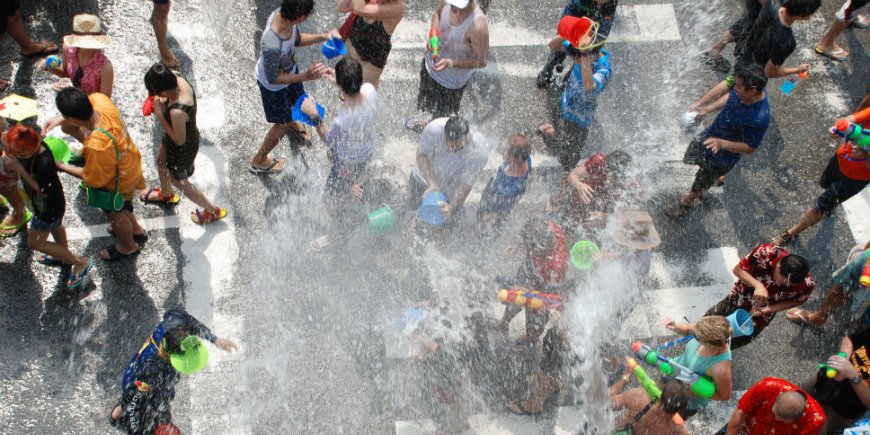
Water. Water. And more water.
It is the main ingredient of the Thai New Year’s celebration, also called “Songkran”.
Water guns of varying sizes, elephants spraying water over people and trucks filled with water are just some of the experiences you can enjoy during the celebration.
Venture outside the hotel’s four walls and you are guaranteed to get wet! And when you get hit by a bucket of water and all your clothes are soaked through, you’ll hear:
“Sah-wah-dee pee mai”, a cry for reconciliation.
The phrase means Happy New Year!
When is Thai New Year?
Thai New Year is celebrated from 13 to 15 April 2025.
Like the Chinese New Year, the event is a holiday for the Thais, and the celebration often lasts a whole week.
Thai New Year was originally held at different times as date of the celebration was decided according to the lunar calendar, but the official start now falls on 13 April every year.
The water festival is the biggest holiday of the year, and many family-run businesses and shops are closed during the celebration.
What is Songkran?
Songkran is the annual New Year celebration in Thailand.
Across the globe, the Thais’ New Year celebration is known and notorious for being the world’s biggest water fight, but for the Thais, the celebration is so much more than that.
The Songkran celebration is the year’s largest public festival and a Buddhist tradition. The colourful festivities therefore also have immense cultural and religious significance, and ancient Buddhist virtues are always an important part of the celebration.
The New Year celebration is about saying goodbye to the bad memories of the year past and ringing in the New Year and good luck. And for that, the Thai people use water.
Songkran is also a family celebration, and many Thais return to their place of birth to celebrate the coming of the New Year surrounded by their loved ones.
How is the Songkran Festival celebrated?
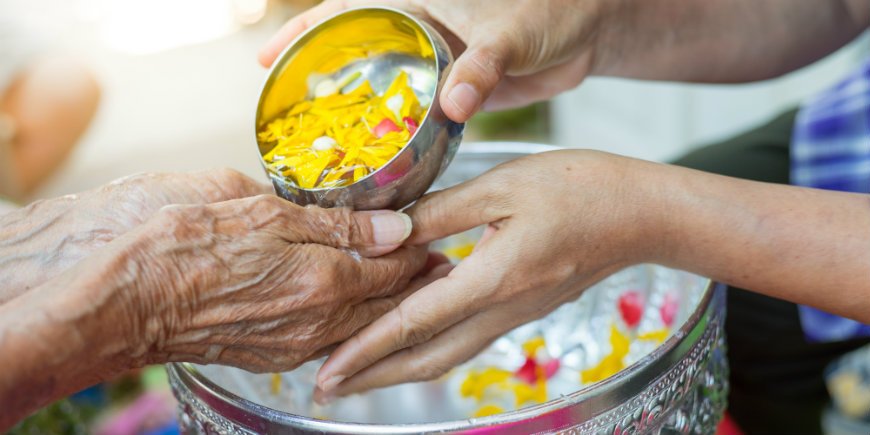
Songkran is a colourful festival where the joy of life of the Thai people is in full bloom.
Before the start of the celebration, it is a tradition to spring clean the house. The Thais clean to wash away the bad luck of the previous year and usher in the good luck of the New Year.
The first days’ traditions
The first two days of the holiday are associated with special traditions.
The first day of the Songkran celebration is in honour of the older Thais. The day is called Rod Nam Dum Hua (in Thai: รดน้ำดำหัว), and children traditionally pour perfumed water into the hands of the elderly. The act is a sign of their humility towards the elderly and to wish them well. The children also ask for the blessing of the elderly when they pour the water onto the experienced palms.
The celebration on day two is about family and it is known as National Family Day (in Thai: วันครอบครัวแห่งชาติ). The most important thing on this day is to be with your family. Families enjoy the presence and joy of each other’s company.
Water festival and the meaning of the water
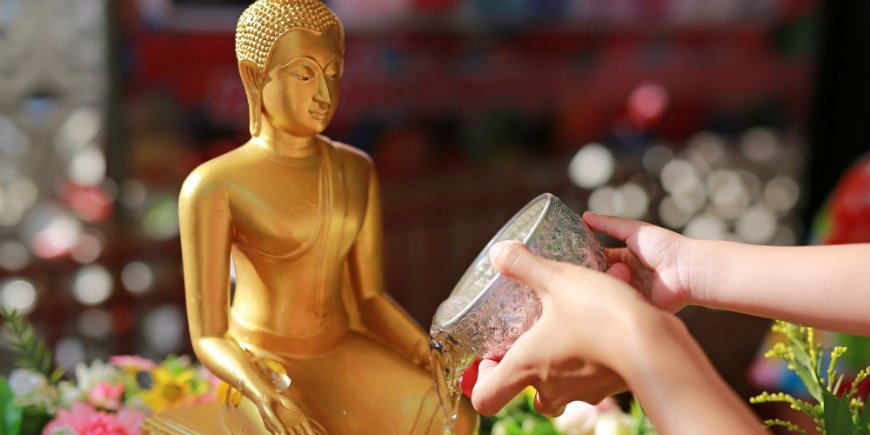
Common to almost all parts of the Songkran celebration is water, which, during the New Year celebration, is synonymous with cleansing and a new beginning.
So water has a very special role. And not just because the water is used for the water festival – the world’s biggest water fight – which the celebrations have become synonymous with in recent years. Although many people might think of water as a fun part of the celebration, it also has an important ritual significance.
The water is not only sprayed on family members, friends and other close acquaintances, but also on people you do not know. The water-splashing tradition is a symbol of wishing away all the bad things that have happened and welcoming the good things.
But it is not only people who get wet during the celebration. The Buddha statues do, too. Both at home and when the Thais visit temples, they pour perfumed water on the Buddha statues. It is an essential religious part of the celebration, called Song Nam Phra (in thai: สรงน้ำพระ). The ultimate achievement for a Thai during the New Year celebration is to visit nine temples during the days of Songkran.
What other traditions are there during Songkran?
In addition to the many traditions associated with water, the Thais also celebrate the coming of the New Year with white pasta, white ribbons and helping the monks.
It is a tradition for the Thai people to offer monks food. The people do this as an offering or by giving alms to the monks. An important part of Songkran is providing for those in need.
It is also customary to tie white threads around the wrists of others while praying for the person you are tying it around. It is a symbol of wishing that person luck. The Thais also smear a white paste on each other to keep ailments away and as a symbol of protection.
In the lead-up to Songkran, the Thais dress in colourful clothes, and crown the year’s “Miss Songkran” while a whole host of festivities take place throughout the country.
Songkran is the celebration of all of them in Thailand.
Where can you celebrate Thai New Year?
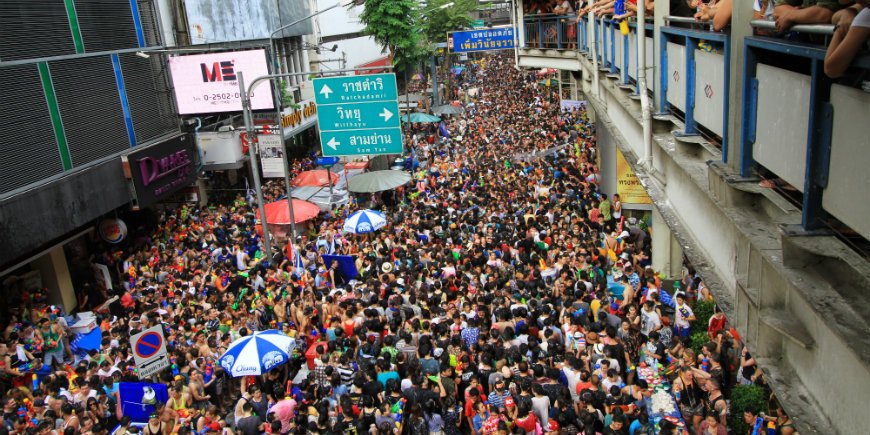
The New Year celebration can be experienced in almost the whole of Thailand. Chiang Mai, for example, in northern Thailand invites happy people to participate in wild New Year celebrations.
The capital, Bangkok, celebrates Songkran on streets such as Silom, which is 5 km long, while in the rest of the country, there are also countless opportunities to experience the New Year celebration at close range.
But beware! Foreigners are seen as easy game by the young Thais throwing water! They love teasing. So you should reckon on getting wet if you venture out into the celebrations.
April, when Songkran is celebrated, is one of the hottest months in Thailand, but the country is big, so it varies a bit. Depending on where in the country you wish to experience New Year, you can read about the climate here.
Bangkok
Thailand’s capital has a lot to offer when it comes to New Year celebrations. The long Silom street offers a riot of colours and cascades of water. The Thais will have equipped themselves with everything that can be used to spray water. You can experience the festivities from above if you are on the BTS Sky Walk that crosses the road.
The backpacker street, Khao San Road, is a wild experience during the New Year celebration. And here, you are guaranteed a soaking! The water shoots in all directions and there is no mercy!
If you want to enjoy a more authentic experience of Songkran, you can head for the Phra Pradaeng district. In the neighbourhood inhabited by the Thai-Raman population, there is not only water splashing but also dancing, a flag ceremony and flower parades.
Chiang Mai
Chiang Mai is possibly one of the best places to experience Songkran. The vibrant celebration takes place in Chiang Mai’s old town for about a week, and besides filled water pistols, colourful parades and festive people, the city also offers a celebration of the louder kind. In northern Thailand, New Year is celebrated with a gunpowder. The gunpowder is shot up into the beautiful sky as a signal for bad luck to stay away.
When the monks in northern Thailand visit the temple during Songkran, they take a bag of sand with them. The sand, which is a symbol of all the dust the monks have carried with them over the year, is made into stupas. In honour of Buddha, the stupas are decorated with flags.
Celebration in other parts of Thailand
Songkran can pretty much be experienced all over Thailand. In some of the smaller towns and cities, you will most likely experience a slightly more authentic celebration of New Year, with greater focus on the ritual aspects than the big water fight.
In the town of Kanchanaburi, you can, for example, experience a unique Songkran tradition: the beeswax candle procession. It is unique to this region, where you can also see an exhibition about the tradition. The procession is the highlight in Kanchanaburi during the New Year celebration.
Want to experience the water festival in 2025?
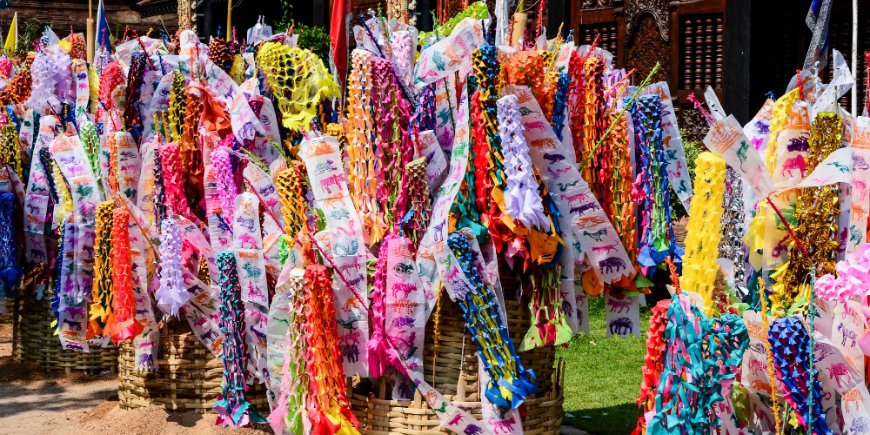
If you would like to experience Thailand during what is perhaps the happiest, warmest and wettest celebration of the year, you should visit the south-east Asian country in the days around 13–15 April.
It’s a time of celebration with colourful festivities on every street corner!
TourCompass – From tourist to traveller
